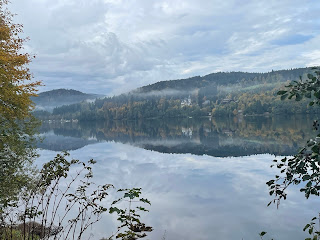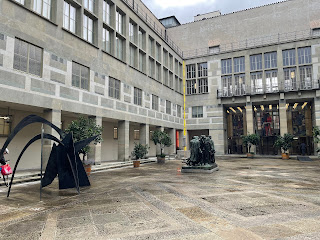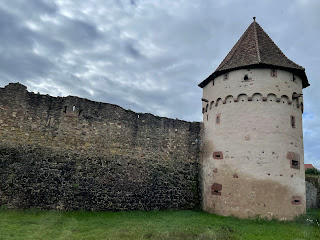By design, this was going to be a pretty easy day, in anticipation of our return home tomorrow. We had a good breakfast at the hotel in Strasbourg, and then most of the morning free to see anything we hadn't already seen there.
We strolled along the river and returned to the Petite France area, which was very picturesque despite the overcast and fog.
Then we continued along the river, back toward the city center, and then back to the hotel. We relaxed and read our books for a while, then ate our lunch sandwiches, checked out, and walked to the railway station, just across the street. A French gentleman about our age, who had lived in the U.S. for a time and had excellent English, struck up a conversation with us as we waited for the train.
Like most European trains, ours to Luxembourg was quiet, comfortable, and environmentally electric. As we left the Rhine valley into northern France and Luxembourg, the land became less flat and more rolling, like Iowa. They grow wheat, barley, and hops here, which makes it beer country.
In Luxembourg City, we were able to check into our room at the hotel, even though it was before 3 p.m. We dropped our bags and took a bus into a different area of the city than we had seen before. Actually, the Grund is just the area at the bottom of the hill, along the river. We had seen it previously from above.
The area was scenic because the sun came out. We haven't seen the sun much on this trip, at all. Looking up the cliffs to the old fortifications was more interesting than walking on top of those ruins, as we had before.
After some climbing up steep ramps, we wound up at the Ducal Palace where we had been previously, and spent a bit of time in a free national museum of historical art. The Roman stuff looked like it does everywhere. There were some interesting 16th and 17th century paintings, however.
After exploring that neighborhood a bit, we found a table outdoors at a cafe and had a drink. As we reflected on this trip, several observations came to mind:
- Europeans smoke a lot more than Americans. They can't smoke indoors, but if you sit outside you'll be breathing a lot of second-hand smoke.
- There are way more immigrants here than there were a few years ago. Some are obviously African, but many more are Middle Eastern. The hijab makes them quite visible.
- Almost no one wears hats. If someone has a cap on, it's likely an American tourist.
- Why can't we have walkable cities like they do here? Cars are mostly on the periphery of city centers. People park on the outskirts, or even in the next town, and ride in on a bus, tram, or train. Then they walk. Americans can hardly walk from the parking lot into Target.
- Probably because of the above, there are far, far fewer overweight people here, and one rarely sees someone obese -- unless it's an American tourist.
- There are lots of electric cars here, but there are fewer Teslas. Electric VWs, BMWs, Mercedes, Hyundais, Nissans and even Fords dominate the EV market. Most Teslas here are taxis.
- Languages change, sometimes just by crossing a river. On the French side of the Rhine, everyone speaks French, even if they have German and English. On the German side, everyone speaks German, even if they have French.
- In German small towns, it's more typical to find people who don't speak English. Germans are more likely to apologize for their English than French speakers are. But of course, both of them speak more English than we speak French or German.






















































